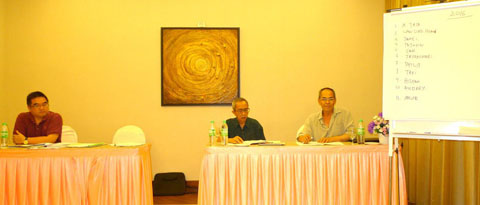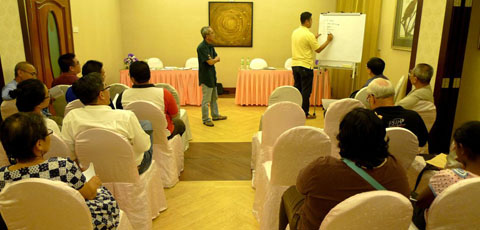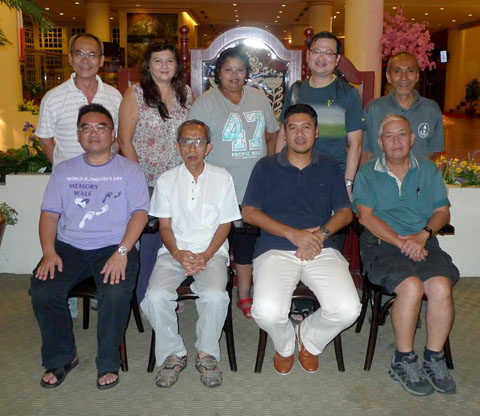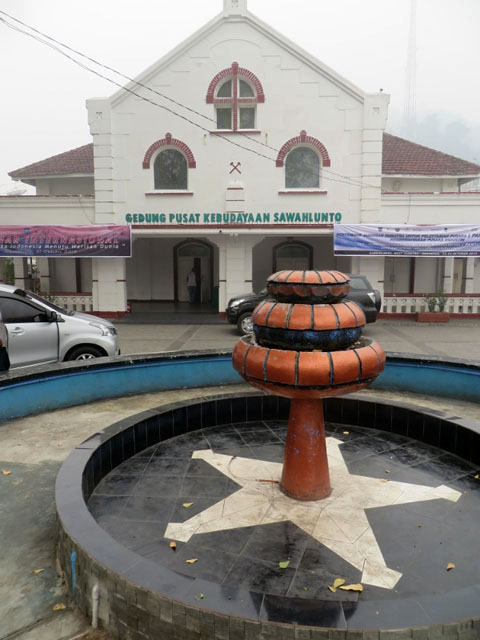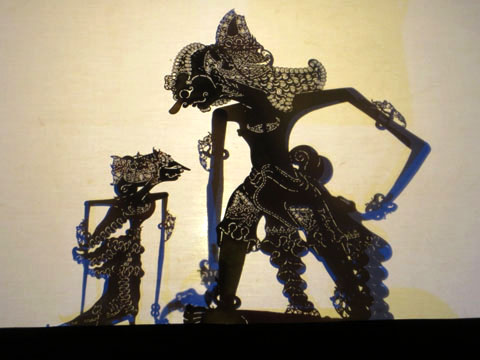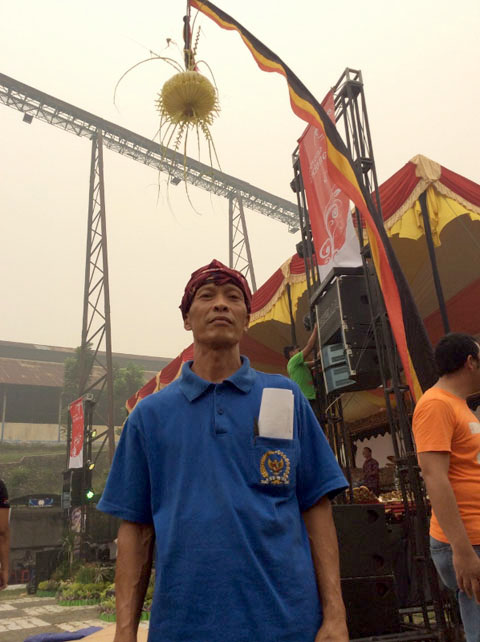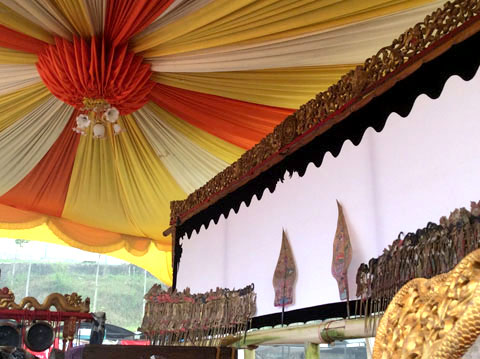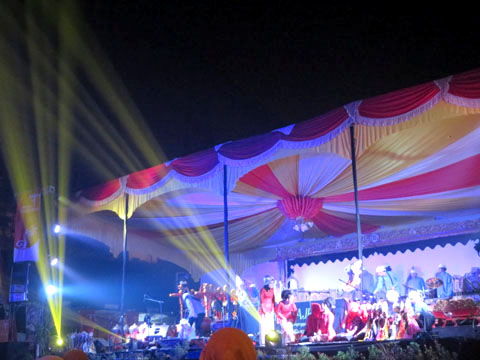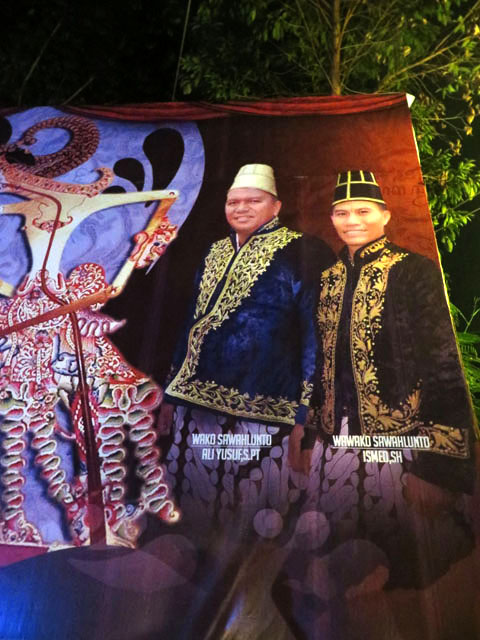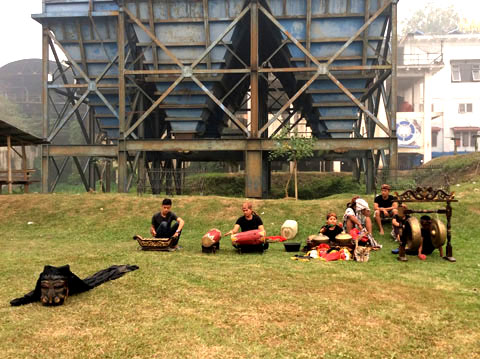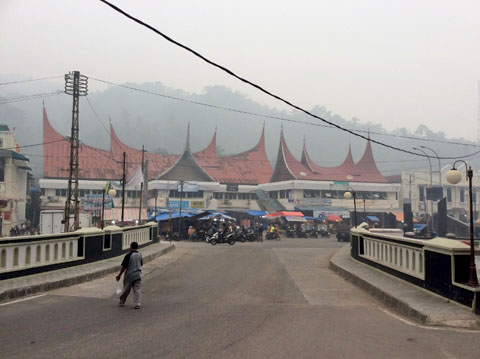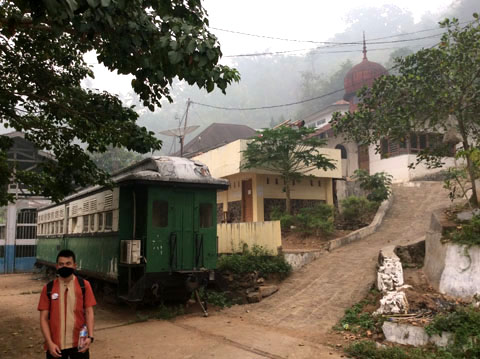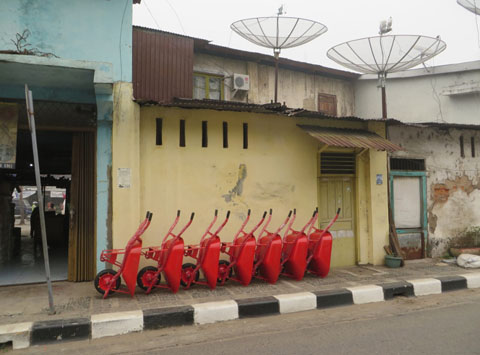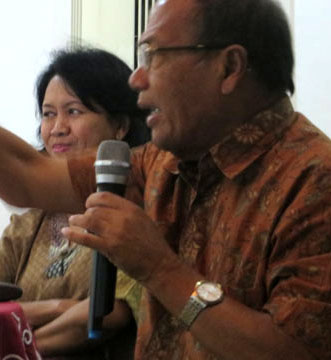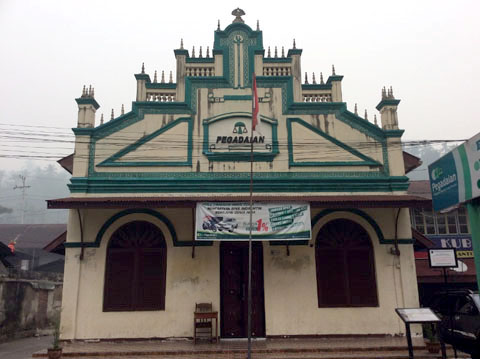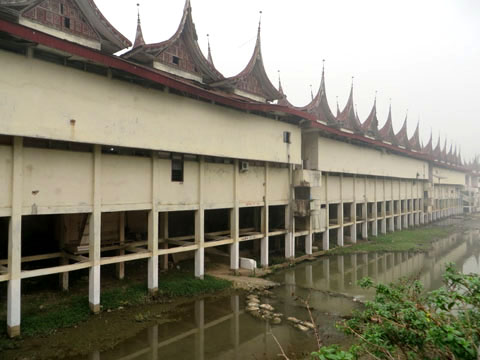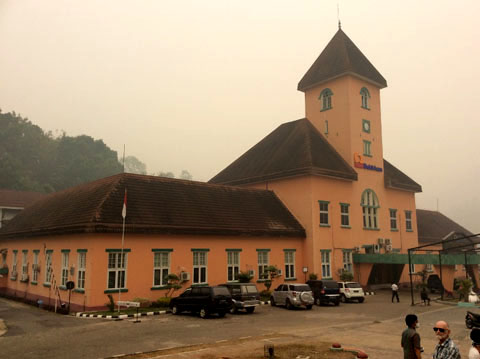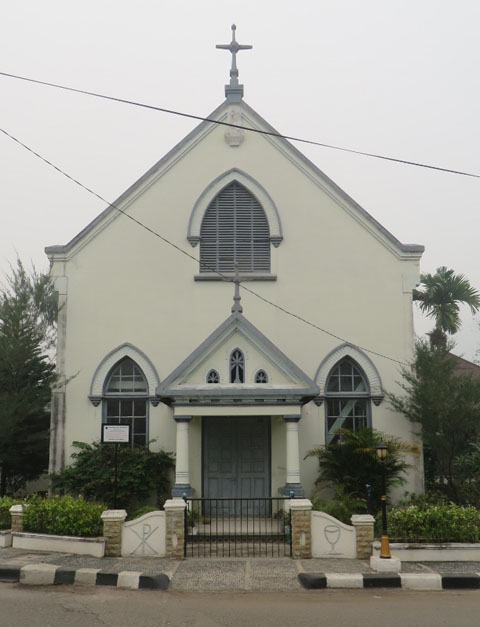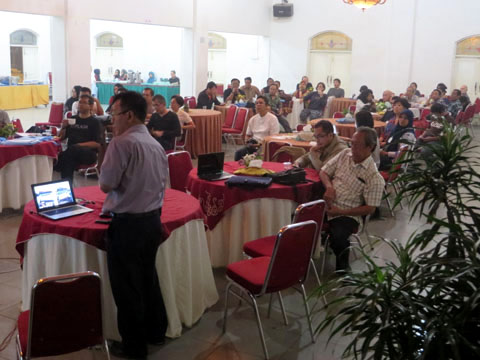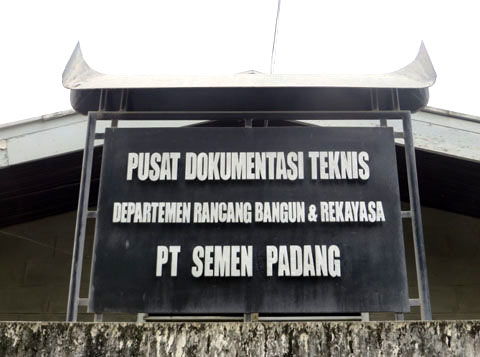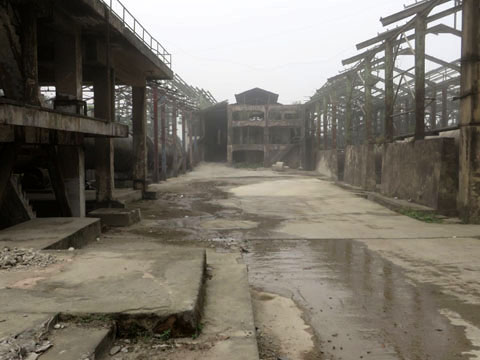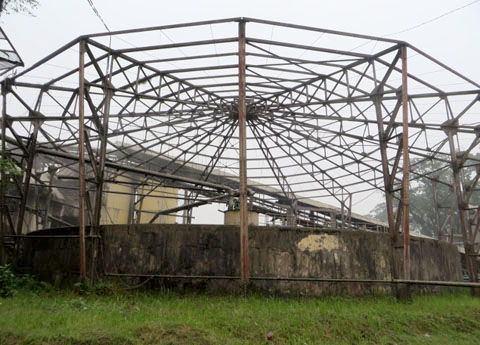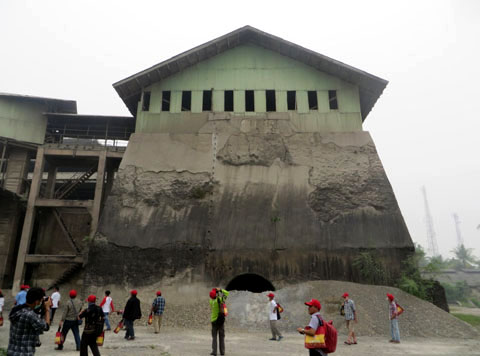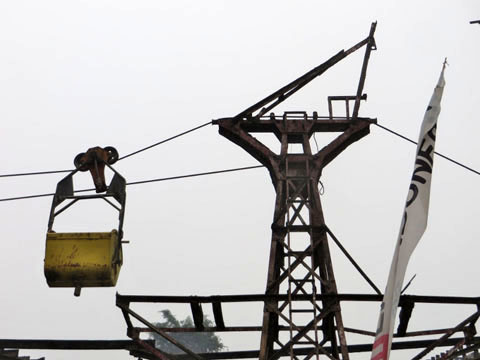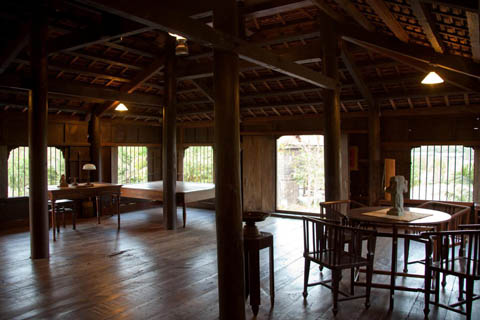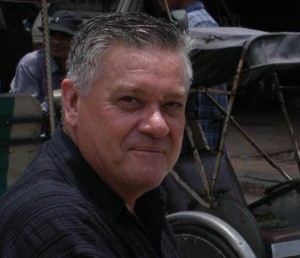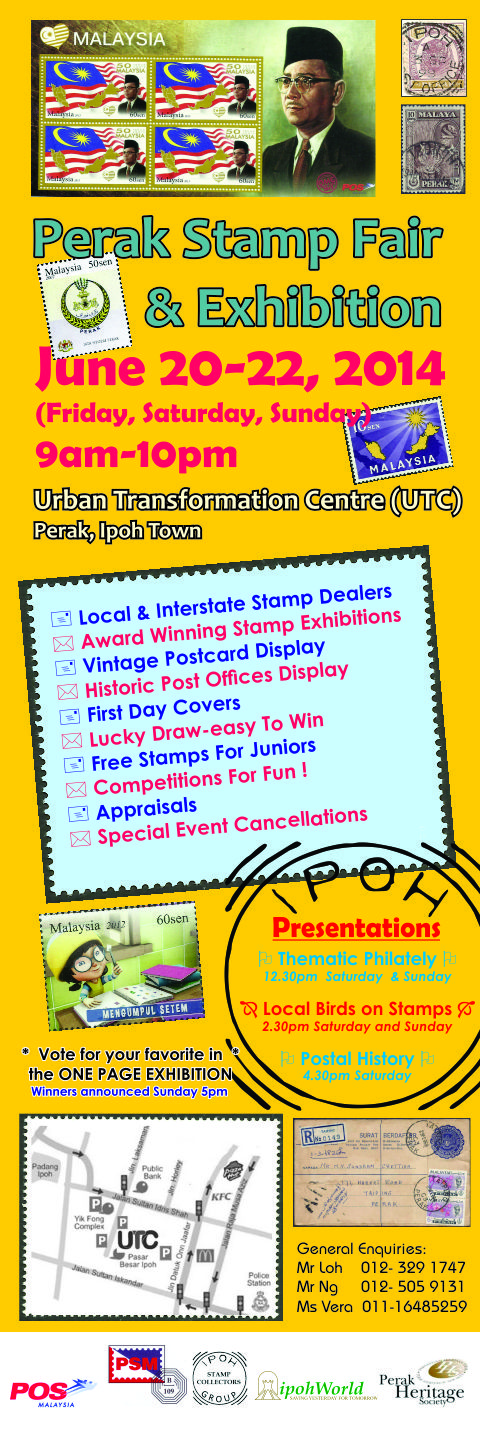Text and photographs by Law Siak Hong
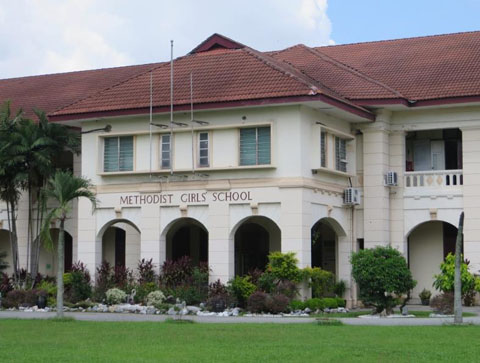
The main building of the Ipoh Methodist Girls’ School, built circa 1930. The principal’s office sits above the porch.
For almost half a century, the mural has lived quietly in the corridor outside the principal’s office, which was, and still is the place students and teachers do not choose to linger.
It was Wai Chun, my Sixth Form schoolmate in ACS Ipoh who told me about the mural. I was intrigued and asked to see it. A couple of years went by. When she finally took me to her old school, I was stunned by her ‘masterpiece’. What a ‘hidden’ treasure! However, I was alarmed to see that the panels had suffered some water damage and electrical conduits and fixtures had run over one of them. Assured of help from me, the intrepid Wai Chun began to mastermind the restoration of this MGS mural in which she had an indelible hand.
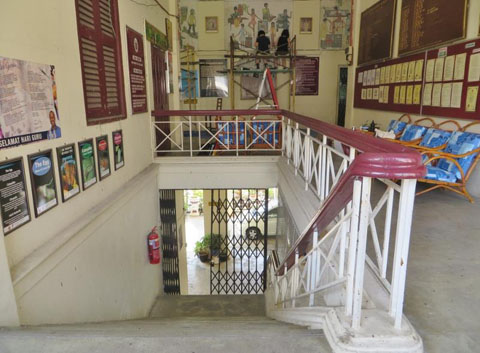
The mural is located outside the principal’s office, seen here in the back wall, during restoration.
Volunteers are critical. They are recruited from among old school friends, but scheduling work sessions to suit them is tough because they live either in KL, Penang or overseas. Support from the school administration for the project has to be sought. Paint and materials must be acquired. The restoration work needs direction and some conservation expertise. Problems abound, but perseverance pays off. The path is set when the school principal Datin Mungit Kaur orders the intrusive electrical fixtures removed; thus, the mural reclaims the wall. The rest, as they say, is history.
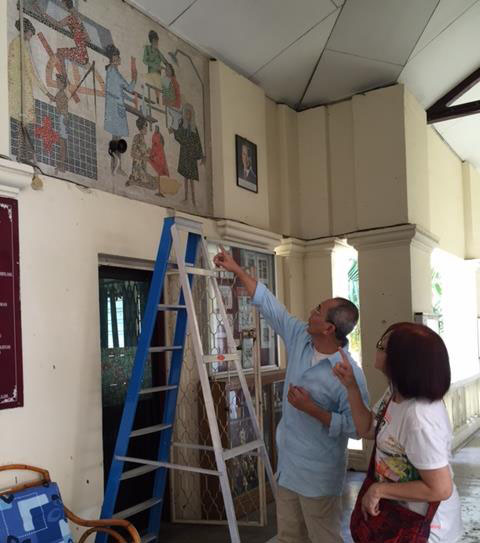
Wai Chun and Siak Hong taking note of the unwelcomed intrusions on the mural.
Back then, under the guidance of art mistress, Mrs Vivian Chong, eleven girls had pencilled their design and coloured it with wall-paint. Wai Chun has kept a black-and-white photograph of the time: girls in shorts, standing on stools stacked precariously on classroom furniture. This time, however, to repair and refresh this extraordinary artwork, a couple of steel scaffolding has been employed; no longer light and stealth, the older and heavier volunteers prefer to work on a steady platform.
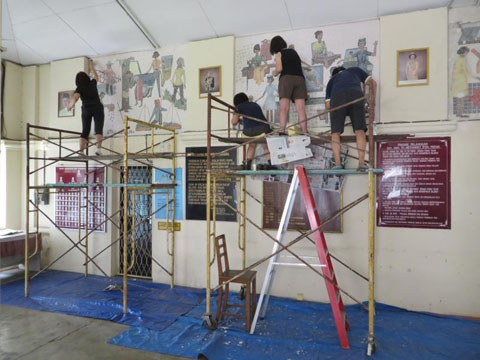
Working from the scaffolding
‘Occupations of Women’, as it was titled, was conceived as a triptych, three panels depicting women at work: manual workers, vocational workers and professionals. Each panel measures 7-feet wide by 5-feet tall. At first sight, the images appear like mosaic. However, upon scrutiny, you would see they are composed of little ‘tiles’, painted in a full spectrum of colours, laid on a pale pink background resembling stonework.
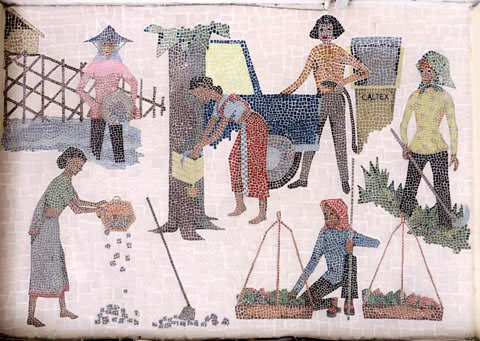
Manual workers. The petrol brand of Caltex was new to the Malaysian market then.
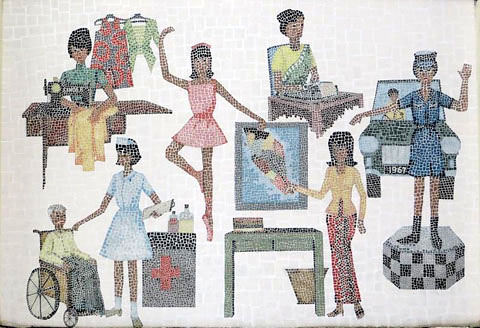
Vocational workers. The year which dates the work is disguised as the car’s registration number.

Professionals. This is the panel which Wai Chun designed.
The figures are girlish, but why not? The women are Asian; they have black hair and their skin tone in shades of light brown. But why styled it like mosaic? Mosaic evokes the venerated decorative art of western antiquities. Painting the mosaic was what the young artists could manage. The result is convincing, and has fooled many casual viewers. Perhaps, the evocation of mosaic was inspired by what Mrs Chong saw during her tour of Europe.
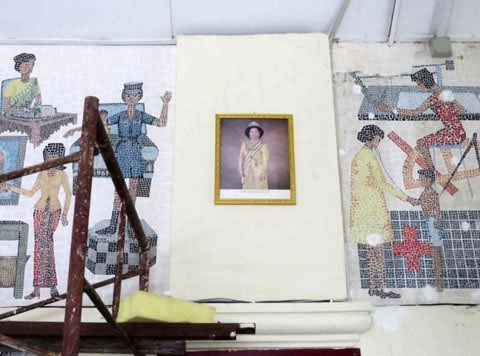
The portrait of the Raja Permaisuri Agong lends weight to this WOMEN only scene.
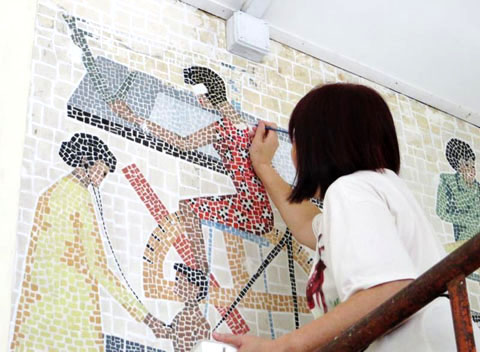
Square by little square, Wai Chun painstakingly brushes on the missing ‘tiles’. Note the architect’s red dress with black and white pattern – the young artists were obviously fashion-conscious.
Wai Chun confesses that the school motto of ‘Our Utmost for the Highest’ is what sustained her through this ‘call of duty’. The process has been time consuming but the experience is both meaningful and satisfying for all concerned. It has fostered old friendships. The volunteer painters had loads of fun despite the painstaking work which none of them are unaccustomed to. Happy or sad, memories of school days live on, perchance to air at opportune time, like when old school friends gather for a worthy cause.
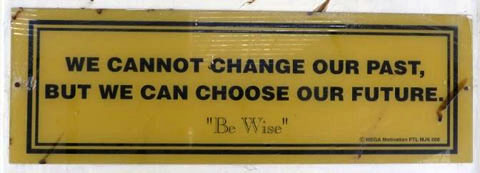
Wisdom runs along the corridor of the main building.
This mural has long been taken for granted. Having endured the passage of time and neglect, it is now primed and poised for glory, as the school advances towards its 120th anniversary celebration in 2017.
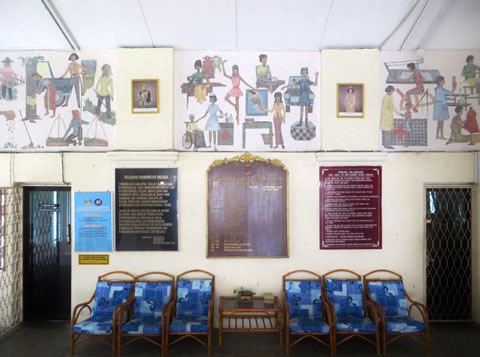
The triptych: Seated on these comfy padded sofas you would miss seeing the ‘women at work’.
Is this mural unique in Malaysia for its subject of women at work? Do tell us if you know of any exceptional school mural with special themes. We will be delighted to document their stories and share them in this PHS blog. ○H
Postscript:
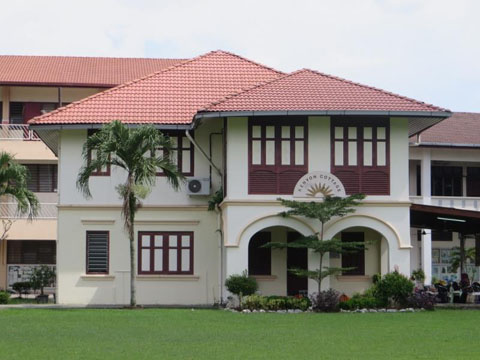
Kenyon Cottage, formerly the headmistress’ residence.
We heard that the building is set to become the school ‘museum’ for the display of its movable heritage and archival material. The PHS notes similar set up in Yuk Choy High School and St Michael’s Institution in Ipoh, and St George’s in Taiping. Please share with us if you know of others.
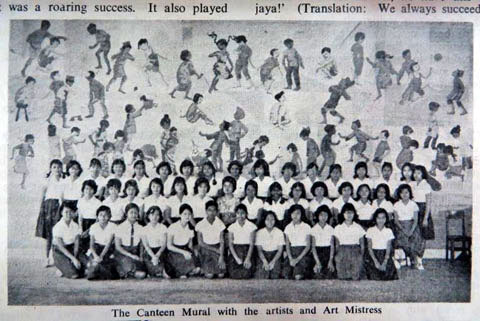
The 1964 edition of the school magazine, ARGOSY, illustrates a new mural at the school canteen shared with the primary school. Incomprehensibly, this vibrant mural, depicting children at play, has been painted over with a far less interesting mural.
UPDATE – 29th December, 2015: A dedication ceremony was held in the school to mark this exemplary effort given to the mural’s restoration. The PHS thought it deserves something special to help fix this memorable advent. Siak Hong sought sponsorship of the commemorative plaque from Royal Selangor. It was a success!
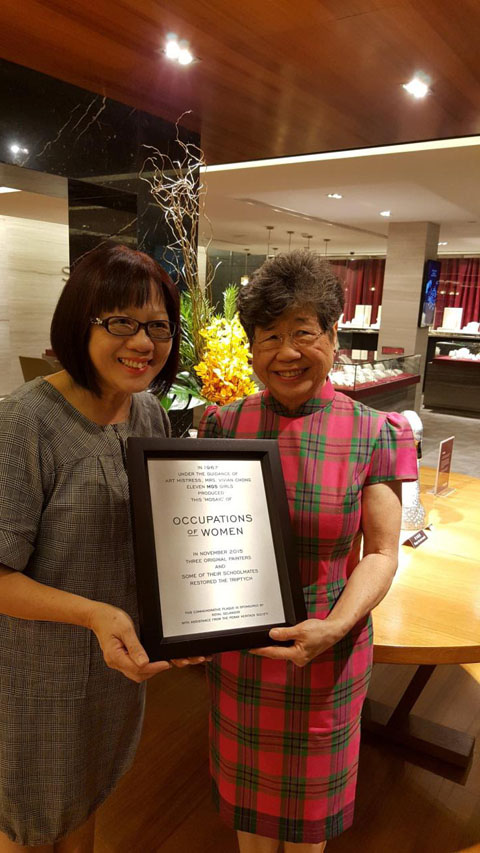
(Above): A week before the dedication ceremony, Wai Chun deputised the PHS in receiving the plaque from Datuk Seri Chen Mun Kuen at Royal Selangor showroom in Setapak, KL.
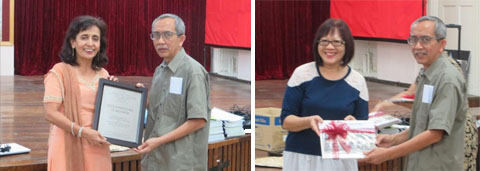
(left): PHS President Mohd Taib Mohamed presents the pewter plaque to MGS Principal Datin Mungit Kaur. (Right): Chan Wai Chun presents a souvenir photo book to PHS. The photo book chronicles the mural restoration process, with messages from Datin Mungit Kaur, Mrs Vivian Chong and reflections from all the girls who worked on the restoration project.
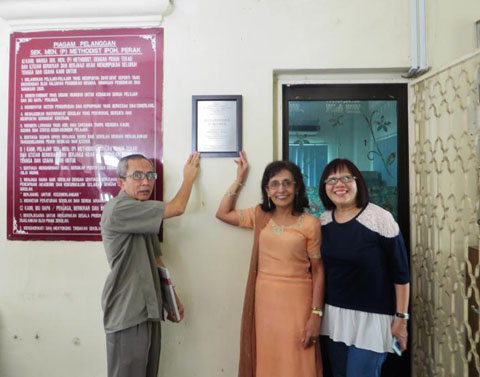
Inscribed with a brief history of the mural, the pewter plaque is fixed to the wall below the mural. No more excuses for not knowing about this incredible mural that is almost half-a-century old.









![ci1|F§pTáÜbbR$»BúƬ(`Éo3ñvZÐ+lkB6A¦=YøÑõ6UH®>«Êµ"µÙÿVLLw¶øv·Ò|ÁTO HÜÑÖTRNÀøûò^2<"K¦ùÎ$c/Õî#EåbUû#n¼ c½:å+TÅuCMa®MpözDW3Z@%Çâbä T ä¼kÙÅüÌn¯tjÍå=2k2öÃÔÐú
¸vøI"¹5yܹC(ôVÓü¡AoÆìE4Õ"ªXnzoQ¸ÉV^´Ï3ÑFÿÉZyGh$]nyOì©;×ÜåøûJcëA¢zH¤ÒKþÓ½a¬s|@Ö )öÁ9´Ã9, ®-Ø^¬£b>Ðö#þ-k·ÿÔêçmvêiìÕ¬*DÉwP)×áåûY_çqÆ@Ïý-H30mü_ÂùCRó6§ÝZY7µ¶¸gc3º82*övÌÝ^|q7+¶ÈÊBzÖ¯à2G.G)a>±*:Ö øfÕâ´¶DsÈÅÃW×ê êâ/½"8ùñ^%«ûÁÊkDjâNÃý3hïS¼ÔõÉôÛèåÕGXÜ<+XÚ2ÿ7ódc®
ñíÍiæMaôûb8·dKLÍ:*ÔSþ,Õ@Kd§½[]STQüº ßR½:)¬ÈU
ÿ6eÇ(8¼qlÜy-@-ãZÀq¹ñ?`OT#Í÷¯4î?^6±ró©§
ÈþrÌ¿ÎO£òÝäö¿¹;9¨Z¸QÇ&Óñ¡EÊɤ$)¾¶«y iÔ4·OT±7Z-¿#R£ÉÃÏPÙkì²ÞÙɲÉv8DÞ-PiUÉjòÔå¿ñ¹q %âp÷¦"ö9ebÖ#W°E*à×âârÝ>A-ÇÛ(ÓíÏÓ{h#ºdøTª¤JÛ
ÿWÄÎ2¿¶µ62
iO$rLhåþSi×êEí¢ÚJ¿¶Hbßv~ÂäXÄ:Üø$gc2ÆÜÅ5$e.RKؽ7OÃð·*ªÓ,oIõ]<ȧ¾oÊþÂq#ÝbZ¨ì¿k¢Ð9?F]Iß$ÑVó«éÑNkj²ÕiðF_ãþÇ/Ñj<9ö¨ÅÇ·$´»6Uc$°åÈ T¶ã:.'OOÿÕèVW"¶¢ÒËJ× æ´ÉEÕ|? W[5ÄwVµÕ¾i¡%é2p3)ONªx~Õ ~,³.8ä"ùb#½+Ëþk²ÝÃ-Å2êàD¿P7E6C&7Í.9n@?0î?@É;ÃÒE& ÅyT6¥þ&|cù®Ëÿ÷d#¤«WUlÛ$4:©
¢ygβéÚ}Õµ°àUÙO¨IFãí` æQ¾µJîÏWÞ[Kå©CªUåpTȰβìxcÀcÒ1ËnªdÍ:<Ü/¯}ÚÖÕVWbô¯
~×fÅ5ün^,"w· ùíî.~§Ú5Û#±LðaG¨ÚÌÖžyÒÛ"%¸A$W*Y ¿vÇåµWPpú̼ÒqÌËÉç¾dó¬õ¨´¶æ6Qê],ù|4<Yºáâ"
ý.L0Ý?òÎg¢ÛE{} ½ëܼ×(O^@ð=Jö|¾âbDº¤F@TI ³õK«ÁxeF#pª~:¶Á·~õ°bÇ'ø¥æÏ4Óô²ß.]ZÜ@n$Dá'À9yJW¢¾ÎÙ$#©6¯¥<ÚzXRkË9e§-ø#Är9ð qy´pc2öÄÙÚZÁwC"Ý$
¹¡VV`ìôr öYV Môk8ÄQ½Þ¤ èÜgȼ}EMPÛÿg(þoû./øÙD¦üɬÒÙà{`©<|h(½E-û"£c¶bBD×F¼Ù|eÒ¯}h%EÓ+(õÝO[ÇÅQ°±ó ,-ì<ŧê®îmô`o¥ù8Æ0â¯S<M.J{Öl&ò¶¢-YZ6ô£WjRâ;c{±A+§¤²ÇýþÏ_lÂicspÚ"X$©Z6èAëòÎGW¤Vôzyq@1¦óf¡mx¿¤P¼UÊÀq¡ÚTtqIrYgüÑ¢B;r<ITö$vöÈAÝÇÉ KªyúuÜo$£9ÛácÞ½Tµ wQÕ-ÓÚ,TAè Û#)nÊmÐzýäÄYPúq'¿3@ ÖµG@äþ@s´#Ólç l¿ßv©ê:¡lâÞy§¸Y)éÈÕ¢%TÒïË.S¹ºg8ÆÂ/µ¾óUÅ-Äñ»lÜð àÏ{#ÉXù¯óÓ©=² ÿ~³°§± ðE(ÓÍaç~ÞËkW0Á
Võ@Pµ'ß%PmôñÐIæMNkÛؤ¿¹rò,äMG#ÄÖ¾ù æpÃ;!nuV%å¹V@²zÛn
õþaÜ#[Ð=i#/"©¶=9n!×ö°Rb¯oæ8î¥&@Dt¥¿oÚ9+{Or·ø¡*ý°Îvã¥V¼{u!Ý ÕÁ&´QØûøeÎëSÄ©A, ¶$PeM|8yAë|RI4ÛA3,øUl<Áj¨6ÖUJ½790H,k¥~akötW¾å«¡cê0¥W£¨UêwË@9ÓáÙÜ#æSÌQ0¨°µjH;¨øz`9$9JÐ1Dóó'XæXÄ®Ö
XI@ÝWìäÎIDsà ©¬¿·+o,v)´©;Hq< @<d;ãL»KGõiÿ3õMXǦ·¢×b¥n[¿-Eeo<±¬¢ROâ¯UßÍðåø³§66Ã`ò4l¤CF«qÅ7¨N7T³ÞÙ糡I»9Ê ëL×ët1Ì/ø¤Õxgú,B(ùÜúl¥Vz znÝ)©éÌvúK¼
Xõ&Pùu_ÑôÜ +:HËĹYçþ,¨I$16ç)e«ûBË*ãó$ErO`t´(}[f FýÇC+ØqTw;%¯<·7pë"D»¢2Ô6VeßìûfëC¤ðýRúv¯?¦?JO¨_Or¶îµ«H=AZø6ã®mAÿ×2ÒͽÐqEò+²ÓfÛ¾cJÄ{Ë'˸#t]bÙÕ¼°õYGÁé3cÛ%$t¨årèÈÌaVo0iÂÐÈüÛá`ì½Èjîxýãë&gøNæÒxP+RKqoÙÈ$ÇIG6vèÎG¬I4;ñÉp±âw5ÚQr¼}I(ïêH¼Í?dcÁù(Ë+B'¹IZ8Bnô*I tr¸ ä[¡ÜI#ýë±w2ñ¢ä¿Õf?B¶CÄÀ¥w£É#ZªÈXFé#Jj~Á,ËN?å|Y`(¥ÃL¼áîGõ9u1
ÓüªãŲÓM¥Î4¤z,Üç£7ÂÔåG;q_ÙÀ%ºLigèùO¥.2¬Mfw4¸ø«üÜü«[È0±<wé11=:Gà´éfºrHÛö ۳ļFM?ÍKGB·È(v ®Ô=?g0¼%¨4¿2ÎÞ88ů EÍn ËIdâ¢jéÈ:¤dxb
hu'1±jIEä+Z;à5Þ»¶úfªòSê²zj䨩ñÁ²´}ÃpijÑÅÕTroO H*}±'¹ig¦Ú¿õd(ÞªY(¥vüàã#xtÚfªIì®±©¬Õîuû²^!<Ñá×$#êþ`ÓçëÍ,hÀdªA5 }#Å µ¼ávÈÉ;zéö¸KFøÛT{øâ%Vyppõ"*«NB7jzÔ|LÝñËYÃäóO×´ÛµI_ë1^2Å:t`j < íСHcêBèÇ®îö®LæÇ#JåÛ9߶£ëIö£ªå')7ÙGqFZyO̱BÝ¥ÖQ°ÓZÒÌárËà&íϹdöQÔ,¦Ic©õdGSs³/ôfÇqÄzx]vQ_U¡!Ô#5ô&I¢R
`µ¯æH÷8Ä%z®¢Þ«(º¼õ÷ ?vMÿÐúöÐ<hÛLµåRhÁ
w5Ì.aÙ m~BQ ªïÄûò<,¸7#Z¼ÎѨ"ø@1;ýø¡Z,ùªx)ä(% »/¸¦ØÖé|*ÖâBAvyDJHÚM[¦ ÓA3¶ÏOJÆ8Z$âÀTGp2&&aFòæ¸îÎKj ÏUDfÜðëL¬Ä¢Ó ÷ëÉÅV^? ß¼zS ûKäÙÛÔb¸ú¢£$nQÜÛÉ° CÇ®[H!´{°&¶¼2°â£r*Xö|1^{×ìå
íËHU8Û×n@ê~Ñï¶ih)F$ló ÜTcÓ~Èø¿ÊÈRbÖmº²è}^ÅZµ®Ô^RÙ"M½Ït÷²¢W´jÒ-O¦+M-Á`bÞÜèÖÓ=T
À¬£.æ¼B) 2TJ6jßO kUoT?;óZõÄ7½rÞɧY.'Ym£JÇÇG#ÈR¥»þÉÀejØH]í¾ ´õ×£T,ª ý[âø²"@}íÜÄÊ*ÑÉÅZL"ýeø²A4Õì³½Ã4fEF,íFã°({W 7òµ¬«Xää*ÔìhÌ nl<0[!Ñ4kkXâëë54 !øð7ÃË RûB²Óê·ÎdU¥ë"%Sað_ø°¤[ó/aÒÄKo¦R
2ÐR¿üK'l8XÑsuu^ÊM@§S¿L#Íw&«ú,ªÒ$ »oÚürgh¸µöâZÅXlFC
6ÌÈVVv ¨$ «óûðTSüÉu¥BC_Ü²Ä ÷B½2H¤éü÷ªh~¥}3ËSêÃ,µ Ï©m°QcCI¯5È-fSorò,ïHÔT*ÆáZ ± {|9-N¾®
EµµÊYÀ÷qNÌV¼J¶HêÐÏM®}q_¬=I@¨ (Û¯ä@dëvú¬Ê«+8¡iHà
;WåÛȢ米7õ¢ñHä§ísö;)i¢µ¥á¼·¹Ðº/ ½6c·ÑÂÃ%£¹x8±±Þ=Jõâ?üðpû9 Ù¡}ªÄY¡`²´R#·VaAAÐ~ÑåvÝ¥×ÂâCn& #¸m£âàÄôå¿òáIn5¶eN|Z7y¹D0ØÑI<I>»pâ8YÀÑA;)¯îly° Ú}½Å²Û×ýÌF2Õ~4r;ÿìrÈRT·[KgU¹!QH³µ Õh£v $Wìÿ1CZ ³z]Í3Gò{HÕj ¹)áðå|mO¥o4&SÒâY@¢XZbÄ,u!!yÖýzÖ¿k ¯çP°åIYñ_à%M@ ¢ü>ø6]Ðêw.v9Þ('eRB ÿÁjBZºÌ(Êà0bv®äüu'6V[{2ÝD/aõÃñoð/qÒ½ñº$ä¢îÄÝÆk¨6{¦°Jci1ÑïígäBÀÖ§¥ï¾K$n6©[ÛV@´ í¹ÛÛ@
÷ß Z}Úù_ mYÈd.
êàü4©øß]Mh¥Ï⥿wA¶Äü=O,!i.Iáùý¸¡$?v[µËüa¨k©ÄÄƳ1Ù)¸ß~øʯdnÿÿÒ
Iygbië2Pë®ÝöÍp·F2Æ(ô ýÓFhj»Êv¦Ýr|Ai5¬Î$'0ç ;T) ? ¾BRg©IÇqpV"©V(G)ì:ìvÀR¤in¦8jÜà$,zßa·ÁbyuåäÒåWⲩ®ÿ ãßìà)»kɽU+lÞF³ò]êhx£ör%W¼ØýYw,Ä»¢-xs©O¿âÀ$:©¥úÓ¢73JíÆ>H]bbßgâéÐñÞìxvM.®ÌÄZ $¼¦¥@ ðìkÅOÚÿ®HH10-=ï«Ëm=w(¯6Pµoî¿Êø²$ìùµ%´³1ÂαÈdy£«²²ê*¤üksµNfZHSÕ¼I¢¯Ü$ü4åÆ5ø¾,!-¯ä|ÑUU×`MC*)BÀvû_ÃÏÒWµ¬RMû
yy"c§ÇéÛcæVcÔÙX.Y®$wZÔ'òåðX«QiÍÔs±æ(ñj§PGÃ_N¿ÙË%¸b6O?K'Õ¥^xüe?â§àPGN¬ÙÊÒécÏä>|I©$~Ï4RË3ZUinKÐrOÚ»a´$wÞv´ûÊ5«=}«Z|$ KY-Ó__óìҽ¥âºÛÚâ·Å·o%½¬òNb¶Ò"J[DÌ"1êWVN¿ì³4è£[Ô,ýn÷+oß ep«ã©;ðóVÇ1g¤äu KjÊÍÅà$³ ]¸Ó0ør)SMfqu4o2Ä[E]ùù7ÀÜ~ÖN[±Iym5£IãÙe=Ï0HZÆÍáü²ªÜâKïRCªýTY4WwI|ÒÉÏÔPÆ)NQªÌwÿW(Ïámǹ±»¦³FQT4 ¶edöé®ãÔ ±ÿ?ø<6§YOi$©êF õaí*Ò¨ûüð@¦k¡ÝôåÔÖry;Ûn+AÿÓç7ðeëÉÐ¥s´Hn̲,¦^27«Ô{Ô±ÊäLá¿DjÂ
~.sLjYAS_øN9Y)n^IÕâªÔâSµ:²¯¶Kn w TjIhêkËf@#íY ),i*P¨ävë@~g K ¸Õ¢æZÞ ´E7ÅĸÝÛsüa ôGøÃõ_-T^ ª*«efA²^j ûÕÐóàªBGìt?hãj{ÒFeOôx[ÕôØÈZqà 4¥£õRëB¥ Êê8Åvß¹-è§kV±ÓæÕÍ¢Ê ÈÒ®ËJ-~Êïñd¯½.H
KCËVÊ1RI oÓóör7E5hÈa³²Ænbº·£%ʪ±Ý¨l¶e-Úå1¹£ä·ÖZÞIdô® -Ux*êT ̧ÛüÀpJ=2DõAÉqxö(-ÚHÐÉYJÐÒ£íâ$ıû½ZðØg
ewAE&5^D§¦KTÅ&kî+R©;|*{¯ì¿$PËMÒˬä)änȪCD Ä÷÷Âs"×K²±¡¶´Á+³Z±?ÿ³RT@}»[¢M"-8$IÊËÖ§}Ùý!êµÛMíµ'ò~Ý4VæVgU'í°EÜæF-^A{´Ï !Òm4#Ooh-uPf°SSËÜ|ÕéÈv °éÖÅÅ*¬8sZ¿Ø¶T¸r+CB~.uqÈÊ,¢PóiE1WcÀCé·@k¢)d×:gÓ2 ¢ñS°ëÜÕªr"m9Ú)9?ÆÈÑIJAϬîÙJ¶v·Ú´lÚÈSéÑB°`yU©êrðÀP¬öÊ!úºNÃÔ'(fnBrè¿üDsäÉ/ú«ÌëJì}9C+³¼B²°<Gû®wSå,!#qûªÅ¨$=ÑÓmMÒùfºç$±)a<" *Ô._$AõKñ=<Ó¹49&Óý;Ùe<Ï?ïE+¿ (Ç~KæÞqú7.ºXæ«`éö7q4Þ´rA½Ô¯XÈÚ»mSÈåV#fFI&Þ¥©G{rhKıIJ¨Ôí#¶ßñÕæÉÆmÌDZ®ííïeÜü<% ?dÈ :)åöû9Aólyîëoëp-EI#`¤U+ñ5¦Ü¶»µê9íâHÞFôG/ýÄ
ìá#0äEX«n»ÓÚiÇü¬4¨¹gÛÚ1ÍÔöG#Pá»|Câl ÚO¬Ì ýÒ¼Õ¬7§ þW,3´3¥ÜÞ@RsD·
+È<A>ºù¤&F§ü2òÙÇI#Ȫ)QÐǦNÑJk+.ÎMÞ?*n0ðÚ©É$mÖµÒwß$^
äv°FÔRÓ¹µlMkâNbÎ^¶]uƦÍ!YtIn¥B ød¿ÿÕAc¼°üÎÔÍ=;{Z$Zp+&µÿ(qT£]ò¦ª#Ið¥Û ¥Q¹"rÜ2QO=Õt;Í)øÌæÁ<©`Àíÿ2Ñ+T-½Æ¡¹RO-ÀøûѲ3'fqtLz¿ ªä»|uBMvû{÷ñýÎ: öªÈà,Sú2`²¨ ¶ÄGìø¨ l, EîU.'2ÙÅQ,
¸òÞ¡UkÊþV7ÙÞèÛùLÖ¦Vàê[¼~·R)õ¡¨ïÊ»ä*,·['Ö}CXÇ0¤=>ØvÚâD^ljÛîkÄv;F òÚcP`Y]@Pü ÷ÞGß39)CQ[±fIíPìE ÅÕ{þÎHcñoÞJ ¤L²ý¦v§BÆÁÂ-x¶Lô;ØÄ×äbµÔR¼xSÃrÙ8F¯ÜÂr¿VÚÝϤaX±bj ù UeÔ ¥)c@ÜW®ÛwǾ«â×EµíE¦nq#©fbH¦æ¦¡®Ü²G¤ÑqjEéÖ 8 õ4¨¥GOV`>$Ʊ|àòÈÒ/+rÚìXdã É`fzPÔ5ccÅû¬r=«ò®G2$ äµ½jï¸ _ '%Ç%§i«d/ Reconstructions at the dig site](https://perakheritage.files.wordpress.com/2019/04/bujang-12-1.jpg?w=175&resize=175%2C117&h=117#038;h=117)

